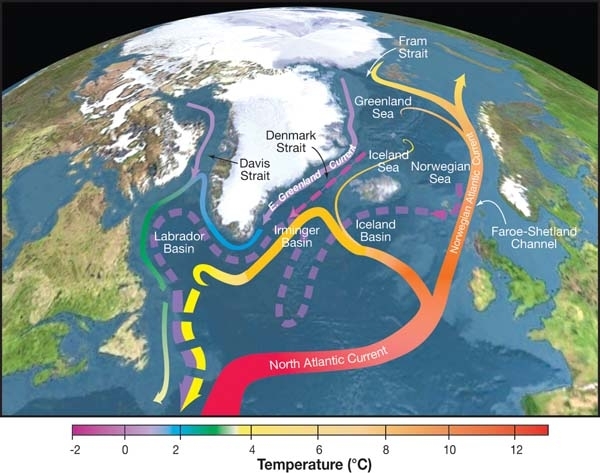…and that ain’t good. (At least, it’s not good for Carbon based lifeforms that live in or near the Atlantic Ocean.)
Oceans are large, dynamic systems, that operate over long, long time periods. We barely understand how it works, even though all life on Earth depends on the oceans. (Our planet should really be called Planet Ocean, not Planet Earth, no?)
One of the really big things that we barely understand is the huge, slow currents that push water north and south and all around in huge circulating currents.
We all know of the Gulf Stream current that flows on the surface near Florida. The Gulf Stream is part of a large system including a corresponding return current that flows deep underwater, like a huge conveyor belt, circulating water, redistributing heat, and moving nutrients in a decades long cycle.
It is impossible to overstate the importance of these currents. These currents support life in the sea, and strongly influence climate on land.
So, if these currents change, we are going to notice because local living conditions will change—fast.
Are the currents likely to change? Well, we’re certainly trying to make them change.
Melting icecaps pours relatively warm fresh water into the ocean, which changes the forces that drive the currents. And overall warming alters other drivers for the currents. And, of course, any changes to these giant currents changes the distribution of warm and cold water, potentially magnifying and speeding up changes to the currents. This makes the systems non-linear (chaotic) and potentially capable of sudden transitions. (Such transitions have been hypothesized in the fossil record.)
There have been indications that major ocean currents have begun to change–probably.
So no one should be happy to see an article this summer with the title, “Current Atlantic Meridional Overturning Circulation weakest in last millennium” [1]. The Atlantic Meridional Overturning Circulation (AMOC) is a system in the North Atlantic, in which warm salty water flows north, and then descends and returns south as a deep, cold, fresher water current.

(Credit: R. Curry, Woods Hole Oceanographic Institution/Science/USGCRP.) (From Wikipedia)
We have solid measurements only for the last couple of decades, so the new study assembled “proxy” measures to infer the state of the currents for much longer time periods.
The proxies include weather records, sediment and ice cores, and measures of ocean conditions. These records measure phenomena that are related to ocean temperature, which represents the state of the currents.
These proxy measures are combined into three timelines representing inferred ocean temperatures. All three timelines show the system was fairly stable until about 1960, when there was a weakening in the currents. The currents increased briefly in the 1990s, and then started declining again.
In short, recent decades have seen a rapid and unprecedented slowdown in these crucial currents. If these results are valid, then this could indicate that the system is entering a sudden transition that could have profound effects on humans and other living things.
Obviously, these results have to be taken with caution. They are based on sparse and indirect evidence. At best, this is a coarse estimate.
However, the overall results are plausible, and the recent changes are verified by much better data from a number of sources: we know that the currents seem to be changing in recent years.
This study suggests that this slowdown is not a normal or frequent event.
That is something to worry about. Not that we can do anything about it.
- L. Caesar, G. D. McCarthy, D. J. R. Thornalley, N. Cahill, and S. Rahmstorf, Current Atlantic Meridional Overturning Circulation weakest in last millennium. Nature Geoscience, 14 (3):118-120, 2021/03/01 2021. https://doi.org/10.1038/s41561-021-00699-z
- Moises Velasquez-Manoff and Jeremy White, The warming atmosphere is causing an arm of the powerful Gulf Stream to weaken, some scientists fear, in New York Times. 2021: New York. https://www.nytimes.com/interactive/2021/03/02/climate/atlantic-ocean-climate-change.html

4 thoughts on “Signs That Atlantic Currents Are Weakening”